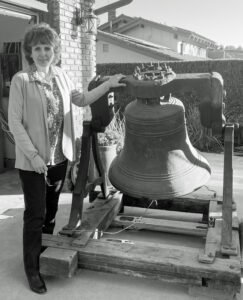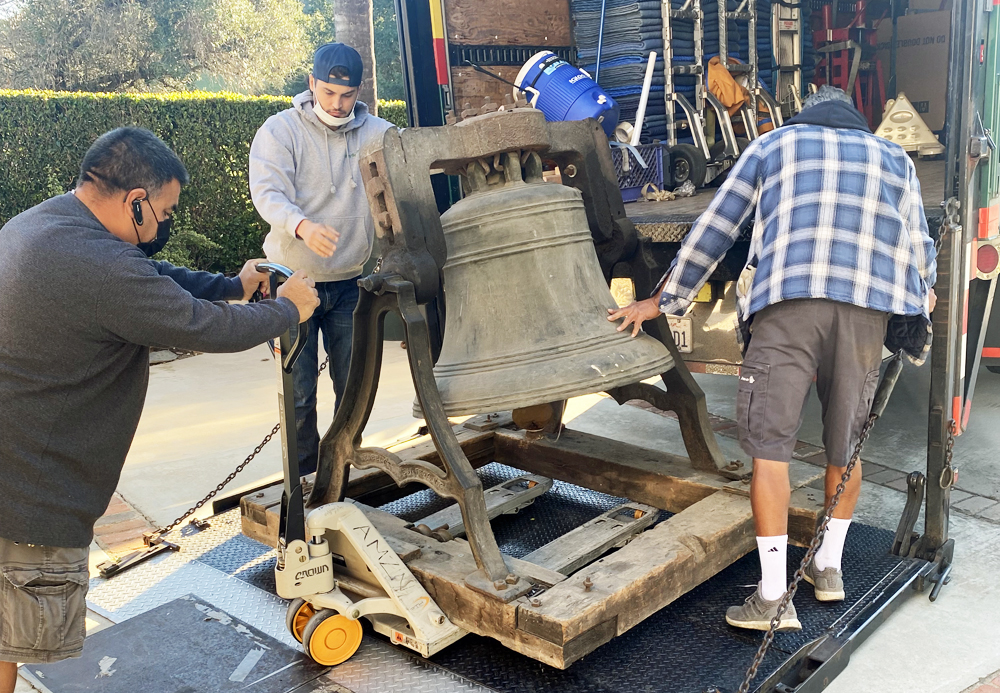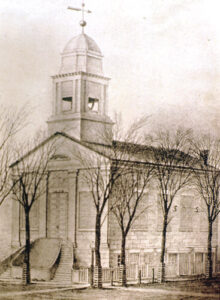True Tales from Canton’s Past: Revere Bell Returns
By George T. ComeauThe following is the latest installment of True Tales from Canton’s Past by local historian George T. Comeau.
Joseph Warren Revere walked across the dusty path that led from his house to the nearby bell foundry. A pair of drowsy-eyed oxen waited, hitched to a heavy oak cart. It was a delivery day and a new bell had been cast that would be sent to another faraway place. Revere took a personal interest in each of the bells as they were made. The words “Revere Boston” were cast along the upper part of the bell that left the foundry in Canton. Paul Revere had taught his son the importance of personally inspecting each and every bell that left the forge. Running his fingers across the family name, Revere then watched the wagon roll out the gates on a 700-mile trip to Cleveland, Ohio. That very same bell is about to return to Canton, tomorrow, after a 3,000-mile trip across America. Tomorrow, the bell comes home.
The Revere family had a long history with church bells. As a boy, Paul Revere signed a contract with Christ Church (the Old North Church) to serve as a bell ringer, even though he attended the New Brick Church of Boston. During the American Revolution, Revere took on the role of his lifetime and is widely hailed as a true founding patriot. After the war, he returned to his roots of metallurgy and began casting a number of useful items for the economic growth of the United States, bells among his line of products.
It all started in 1792, when Revere’s congregation of the New Brick Church sought to replace their bell that had cracked. Revere, with a reputation for taking on impossible tasks, believed he could cast the large bell to replace the one that had been “injured.” The casting of the 912-pound bell was not entirely successful. It had visible imperfections and a poor tone quality. Revere persevered and through the iterative process of failures and successes, his bells became better and more refined. Working closely with Joseph Warren, he built a flourishing enterprise while proudly proclaiming their bells to be “as good as can be cast in the world, both for goodness and for sound.”
Originally located in the North End, Revere’s foundry began by producing materials for shipbuilding, such as nails and fittings, before developing the ability to produce more recognizable items like bells and canons. On October 9, 1804, an unusual late-season storm yielded vast amounts of snow, rain, and powerful winds across the northeastern United States. Known as the Storm of October 1804, it was the first hurricane in recorded history known to have produced snowfall. The devastation was widespread and included the foundry that was located along the waterfront in Boston. Revere and his son decided to move the entire operation to Canton, where the copper rolling mill had been established in 1801. In November 1804, Joseph Warren set off for Europe in order to gain even more technical knowledge of both copper rolling and the production of large bells.
Upon Paul Revere’s death in 1818, Joseph Warren took on the primary role in the casting of bells and through subsequent corporate name changes continued bell making until 1843. The name “Revere Boston” appeared on bells as early as 1822 through 1843, and the last bell entry in the Revere stockbooks was dated 1828, though bells made after 1824 did not carry a date on them. More than 969 bells were cast with the Revere name, and many were cast right here in Canton in a foundry building that was demolished after 1965.
In Cleveland, Ohio, there is a landmark church called the Old Stone Church. Officially known as the First Presbyterian Church of Cleveland, it was founded in 1820, when Cleveland was a village of a few hundred people. The first church building was dedicated in 1834. Since it was made of gray sandstone, it became known as the “Stone Church.” Later, as the sandstone darkened, it was called the “Old Stone Church.”
The bell that left Canton was likely the one that hung in that steeple. A slightly larger structure was constructed in 1853 on the original church site as Cleveland began to grow rapidly. It was about that time that the First Congregational Church in Vermillion, Ohio, formed a society whose object was to purchase a bell. The bell this society bought had hung in the belfry of the Old Stone Church in Cleveland.
From 1853 to 1954 the bell was in the hands of the Congregational Church, and when the building was sold to the Baptist Church, it continued to peal on Sundays and special events over the ensuing decades. In the early 1980s the church was sold and passed into private hands. The bell was bought by Jeannene and Robert Shanks. Amy Shanks Miller tells the story of the bell: “Mom told us that she was buying a bell, and we all thought she was kidding. But, the way Mom saw it, the bell needed a home and for around $1,000 she made the purchase.”
In 1958, Jeannene and Robert had relocated to Vermilion, Ohio, when Robert took a new position with Ford Motor Co. Jeannene was a housewife and real estate agent in Vermillion. They remained in Ohio until Robert’s retirement from Ford in 1983. The bell was purchased near the end of their residency in Ohio, which meant that when she and Robert moved to California, they would move the bell with the Mayflower Moving Company. “Mom would joke that the bell came over on the Mayflower,” Shanks Miller recalled.
The bell sat in a storage locker for a time, and then between 1990 and 2008 it was at Jeannene’s house in Chino Hills, California. When she died, the bell moved less than a mile away to her daughter’s garage, where it was rung ceremoniously on July 4. “About 10 years ago I began to think about a home for the bell,” Shanks Miller explained. “A rancher from Texas offered us a lot of money and said that if it didn’t work out he could always melt it down for scrap salvage.” Shanks Miller was shocked, and began working to find a suitable home for the bell.
Carl S. Zimmerman is an industrial archeologist and noted campanologist — a person who studies bells. This author first worked with Zimmerman in 2008 when trying to save the Revere Rolling Mill and Joseph Warren Revere Barn. Zimmerman talks of bells — the headstock, the bearing blocks, the clapper, the cannon — retaining yoke and gudgeon. After seeing photos of the Revere bell, he marveled, “It is the real deal, and that octagonal wrought iron from which the ball of the clapper hangs is quite interesting.”
There is much more to learn about this bell, and we are just getting started. “Revere had the time, opportunity and interest and was one of the earliest men to cast bells in the United States,” Zimmerman said. Folklore suggests that a tiny bit of silver was the secret ingredient in perfecting the tone of Paul Revere’s bells.

Amy Shanks Miller stands proudly next to the Revere bell that was purchased by her mother in 1982. (Photo courtesy of Amy Shanks Miller)
Thirteen years had passed since the first meeting with Zimmerman and the Revere Heritage Site had become a reality. Zimmerman was now helping Amy find a home for what she affectionally called her “younger sibling” — the Revere bell. One of the first calls was to the Paul Revere House. There is a Revere bell from 1804 on exhibit in the North End home of Revere in the museum courtyard. They referred Zimmerman to this author, which led to extensive discussions via phone and email.
Of great relief, Amy wrote in September 2021, “I am interested in knowing the bell would have good purpose and care.”
Thus, over the next several months, we all worked to have the bell contributed to the Revere & Son Heritage Trust. On January 14, 2022, the bell was donated by Amy Shanks Miller and her brother Robert Shanks as a gift from the legacy of their parents to the Paul Revere Museum of Discovery and Innovation. Only one problem remained — getting a 2,000-pound bell, along with frame and cribbing, home to Canton, Massachusetts.
Through the efforts of several individuals, led by Alan Hines, a Revere Heritage Trust director, several thousand dollars was raised to ship the bell back east to Canton. And, once again, Mayflower Moving Company loaded the bell onto a truck for the transcontinental trip. Tomorrow, if all goes according to plan, the bell cast here in 1834 will arrive back with much fanfare. It will be the second Revere bell in Canton, as the first hangs in the belfry of the First Parish Church and dates to 1824. To bring this bell home took almost seven months and much planning.
The bell will be in temporary storage while ideas are underway for a permanent public display. Plans are to show the bell at the Canton Heritage Day event on May 14. Cast at the hands of Joseph Warren Revere, this bell took a fascinating trip through history and five trips to come full circle. Welcome home!
Short URL: https://www.thecantoncitizen.com/?p=84691












